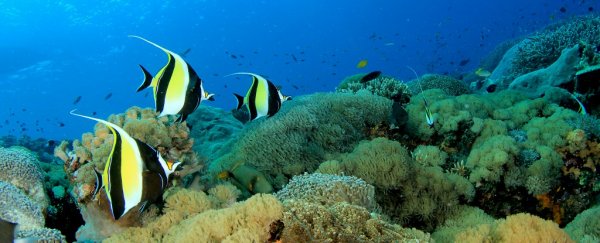Researchers are investigating which tropical fish species are likely to leave their homes and establish new populations in cooler waters as the world heats up due to climate change – and they've found some clear winners and losers.
Each year, a huge amount of tropical fish larvae are accidently transported from Australia's Great Barrier Reef to cooler waters further south by getting caught in the East Australian Current.
Nearly all of the fish larvae die once they hit the cooler temperatures, but thanks to the effects of climate change and the rapidly warming oceans, that soon will change.
"Scientists are trying to understand which species will be winners and losers under a warmer future in order to make predictions about how the planet's biodiversity may be impacted and how the functioning of ecosystems may be altered," said one of the researchers, Rebecca Fox, from the University of Technology Sydney (UTS).
It's not that surprising that fish and another animals migrate closer to the poles as Earth warms up – because if they stick around in an environment that's too hot for them, they'll struggle to survive.
But we still have very little idea of how this will effect migrating animal populations in the long run, and what this will mean for the animals that are already inhabiting the cooler areas.
It's important to figure that out, because the shift towards the pole isn't great for tropical or native fish. Fox and her team suspect that migrating tropical fish will become invasive species in the cooler areas, possibly pushing out their native rivals.
To find out, the researchers looked at the different morphology (body shape) of a number of fish species to predict how successful they would be at invading the cooler waters.
"As minimum water temperatures rise, more and more of these tropical fish will be able to survive the entire winter and potentially set up breeding populations," said one of the team, Shannen Smith.
"It will then be the ability to compete for and share resources that will determine which of the tropical fish can coexist as a population with the established temperate residents. Body shape can tell you a lot about the way a fish lives and the niche it occupies in the community."
The species most likely to invade the Southern waters? A species of butterfly fish called the Moorish Idol.
"The Moorish Idol currently lives in tropical waters and doesn't appear to tolerate colder temperatures," Smith said.
"However its body shape suggests that the way it lives would not bring it into direct competition with native fish species, meaning that it might be able to coexist with the locals living in warmer waters on the southeast coast of Australia."
That's the best case scenario, though - the paper also points out that the native species in cooler waters would suffer, concluding that, "impending competitive pressures may impact disproportionately on particular parts of the native community".
"[The] research predicts which of the tropical reef fish species that are transported to Sydney each summer on the East Australian Current might have the best chance of establishing viable populations here in the future and, in turn, which segments of the native fish community might be most impacted by the invaders," said Fox.
Now that there's no escaping the effects of climate change, it's crucial that scientists have a handle on what's likely to happen to life on Earth as things continue to heat up.
Hopefully this research will help scientists to better understand what will happen in the future, and how to protect both tropical and cooler climate fish from it.
The research has been published in Biology Letters.
UTS Science is a sponsor of ScienceAlert. Find out more about their research.
